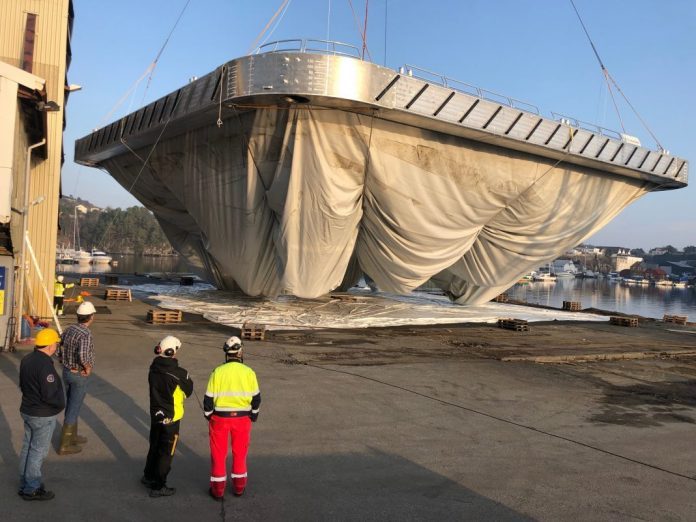Behold the new cage from Ecomerden has arrived.
High above, it resembles a spacecraft from one of the Star Wars movies, hanging on steel wires. It looks ready to take off at any time.
The heavy lifting is being carried out by the crane vessel “Trond Lift 6”, easing it into place at Sagvåg on Stord, near Bergen, on Norway’s southwestern coast. The crane is owned by the shipping company Tronds Marine Services, formerly Eide Marine Services, and is wholly owned by Tysnes-based salmon farmer Gerhard Alsaker.
The canvas hung heavily under the aluminium frame, splashing water.
Heavier load
“I see there is a lot of water in it,” said Jan Erik Kyrkjebø. He’s certainly staring but he’s not worried about the construction that has taken five months to build. “We have leaked it, but there’s probably 4-5 tonnes of water in it.”
SalmonBusiness has been invited as the only media representative to cover the event and anniversary of Ecomerden.
It’s a 45-tonne rigid aluminium floating cage, equipped with a 12-tonne canvas. With the water inside the cage, at least 60 tonnes hang in the air. A heavy lift, but “Tronds Lift 6” can go on further. The crane is designed for loads that are 12 times heavier.

“The canvas is made from PWC polyester, documented and offshore tested. It has a tensile strength of 30 tonnes per metre length. The area for the cage is 1,000 square metres, while the tablecloth is 4,000 square metres,” said Jan Erik Kyrkjebø.
Launched
Kyrkjebø is an engineer and inventor and has already tested his ideas with several generations of salmon in a semi-closed post-smolt cage that has been in service at the salmon farmer Sulefisk in Solund municipality, Western Norway.

Now there is another Sognefjord native who is in charge, Osland Havbruk.
The cage will be lifted out of the waves, then launched and towed northward by a tugboat. The cage’s trip up to Sognefjord is expected to take 40 hours.
“There’s a weather window now. It will arrive in Sogn (Western Norway) on Thursday morning. Travelling overnight,” said Osland’s operations manager Johnny Kalstad.
Feast
The cage is made from parts of aluminium, produced in Sweden, and welded together on site at Sagvåg on Stord.
On the question of how much this all costs, neither parties will comment.
“Too expensive,” smiled Kalstad cheekily. “Too cheap,” countered Kyrkjebø straight away.

